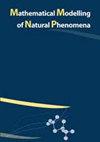地幔中质子迁移的数学模型
IF 2.1
4区 数学
Q2 MATHEMATICAL & COMPUTATIONAL BIOLOGY
引用次数: 1
摘要
在这项研究中,我们解决了地球地幔中质子迁移的数学问题,并提出了一个用于探索地球内部以绘制超电子质子传导效应的原型。通过推导自洽电磁场势U(x,t),然后重构分布函数f(x, v, t),可以在数学上解决该问题。将Vlasov-Maxwell方程组简化为非线性sh-Gordon双曲方程和输运方程,研究了非线性波前在域内的传播和边界条件以非线性波形式的输运。通过计算三维模型和傅里叶分析,研究了电位U(x, t)的空间和电特性。数值结果与通过电势场观测(库兹涅佐夫法)得到的电位(V)的傅里叶变换量进行了比较。该数学模型可以有效地求解双组分系统强迫振荡的非平稳解,从而求解两种带电粒子的振荡强度。此外,该模型与电势观测数据分析和概率地震危险度图一起,可用于开发先进的地震风险度量。本文章由计算机程序翻译,如有差异,请以英文原文为准。
Mathematical modelling of proton migration in Earth mantle
In the study, we address the mathematical problem of proton migration in the Earth’s
mantle and suggest a prototype for exploring the Earth’s interior to map the effects of superionic
proton conduction. The problem can be mathematically solved by deriving the self-consistent electromagnetic field potential U(x,t) and then reconstructing the distribution function f(x, v, t). Reducing the Vlasov-Maxwell system of equations to non-linear sh-Gordon hyperbolic and transport equations, the propagation of a non-linear wavefront within the domain and transport of the boundary conditions in the form of a non-linear wave are examined. By computing a 3D model and through Fourier-analysis, the spatial and electrical characteristics of potential U(x, t) are investigated. The numerical results are compared to the Fourier transformed quantities of the potential (V) obtained through field observations of the electric potential (Kuznetsov method). The non-stationary solutions for the forced oscillation of two-component system, and therefore, the oscillatory strengths of two types of charged particles can be usefully addressed by the proposed mathematical model. Moreover, the model, along with data analysis of the electric potential observations and probabilistic seismic hazard maps, can be used to develop an advanced seismic risk metric.
求助全文
通过发布文献求助,成功后即可免费获取论文全文。
去求助
来源期刊

Mathematical Modelling of Natural Phenomena
MATHEMATICAL & COMPUTATIONAL BIOLOGY-MATHEMATICS, INTERDISCIPLINARY APPLICATIONS
CiteScore
5.20
自引率
0.00%
发文量
46
审稿时长
6-12 weeks
期刊介绍:
The Mathematical Modelling of Natural Phenomena (MMNP) is an international research journal, which publishes top-level original and review papers, short communications and proceedings on mathematical modelling in biology, medicine, chemistry, physics, and other areas. The scope of the journal is devoted to mathematical modelling with sufficiently advanced model, and the works studying mainly the existence and stability of stationary points of ODE systems are not considered. The scope of the journal also includes applied mathematics and mathematical analysis in the context of its applications to the real world problems. The journal is essentially functioning on the basis of topical issues representing active areas of research. Each topical issue has its own editorial board. The authors are invited to submit papers to the announced issues or to suggest new issues.
Journal publishes research articles and reviews within the whole field of mathematical modelling, and it will continue to provide information on the latest trends and developments in this ever-expanding subject.
 求助内容:
求助内容: 应助结果提醒方式:
应助结果提醒方式:


